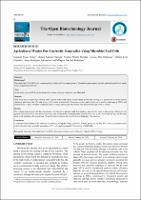Mostrar el registro sencillo del ítem
Agricultural wastes for electricity generation using microbial fuel cells
| dc.contributor.author | Rojas Flores, Segundo | |
| dc.contributor.author | Nazario Naveda, Renny | |
| dc.contributor.author | Abanto Paredes, Evelyn | |
| dc.contributor.author | Alza Orbegoso, Jessica | |
| dc.contributor.author | Cruz Céspedes, Tiffany | |
| dc.contributor.author | Rodríguez Salvatierra, Angie | |
| dc.contributor.author | Sánchez Rodríguez, Milagros | |
| dc.date.accessioned | 2021-04-27T16:59:49Z | |
| dc.date.available | 2021-04-27T16:59:49Z | |
| dc.date.issued | 2020 | |
| dc.identifier.issn | 1874-0707 | |
| dc.identifier.uri | https://hdl.handle.net/20.500.12692/58291 | |
| dc.description.abstract | Background: Microbial Fuel Cells (MFCs) are promising devices that enable the employment of discarded organic matter, typically gathered around food supply chains, to generate electricity. Aims: In this work, low-cost MFCs in the absence of a proton exchange membrane were fabricated. Methods: They were built on polyvinyl chloride (PVC) plastic tubes with square acrylic sheets at the ends serving as a framework of anode/cathode chambers and using zinc (Zn) and copper (Cu) metals as electrodes. Tomatoes, onions, and potatoes were used as substrates in MFCs and monitored for 21 days. Variables of interest such as voltage, current, pH, and volume were measured through a 100 Ω resistor. Results: The voltage measurements for the onion-based cell showed an upward trend that reaches a peak of 1.01 volts on the last day. Moreover, the greatest current generation was observed in onion cells, in which the current gradually increases from 10.2 to 24.7 mA on the last day. On the other hand, in all substrates, pH ranged from 7.5 and 10, which indicates the slightly alkaline behavior of the solutions. Conclusion: A reduction in the volume of the substrate was observed during the voltage generation. Finally, during the last day, MFCs were connected in series which allowed for the successful generation of 2.35 volts, and consequently, illumination of LED light. | en_US |
| dc.description.uri | Trabajo de investigación | es_PE |
| dc.format | application/pdf | es_PE |
| dc.language.iso | eng | es_PE |
| dc.publisher | Universidad César Vallejo | es_PE |
| dc.relation.ispartofseries | The Open Biotechnology Journal;14, 52-58 | |
| dc.rights | info:eu-repo/semantics/openAccess | es_PE |
| dc.rights.uri | https://creativecommons.org/licenses/by/4.0/ | es_PE |
| dc.source | Repositorio Institucional - UCV | es_PE |
| dc.source | Universidad César Vallejo | es_PE |
| dc.subject | Combustibles biológicos | es_PE |
| dc.subject | Electricidad | es_PE |
| dc.subject | Residuos agrícolas (combustible) | es_PE |
| dc.title | Agricultural wastes for electricity generation using microbial fuel cells | es_PE |
| dc.title.alternative | Residuos agrícolas para la generación de electricidad mediante pilas de combustible microbianas | es_PE |
| dc.type | info:eu-repo/semantics/article | es_PE |
| thesis.degree.grantor | Universidad César Vallejo. Escuela de Posgrado | es_PE |
| dc.description.sede | Chimbote | es_PE |
| dc.description.peerreview | Revisión por pares | es_PE |
| dc.identifier.doi | https://doi.org/10.2174/1874070702014010052 | |
| renati.type | https://purl.org/pe-repo/renati/type#trabajoDeInvestigacion | es_PE |
| dc.subject.ocde | https://purl.org/pe-repo/ocde/ford#2.01.01 | es_PE |
| dc.publisher.country | PE | es_PE |
| dc.relation.isPartOf | urn:issn:1874-0707 | es_PE |


